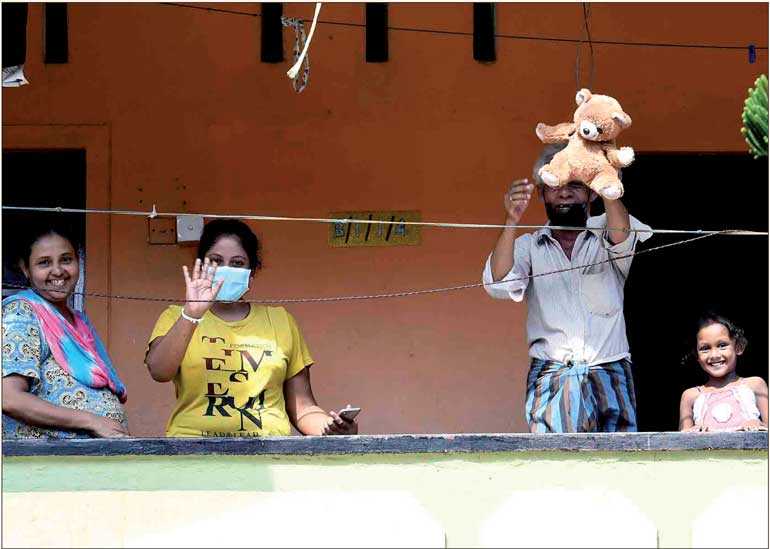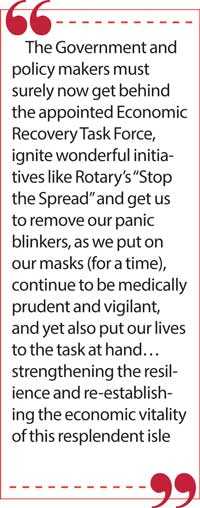Thursday Apr 17, 2025
Thursday Apr 17, 2025
Friday, 1 May 2020 00:00 - - {{hitsCtrl.values.hits}}

While we must continue to test, take precautions, wear masks, socially distance, apply all the hygienic best practices, perhaps, just perhaps these numbers make a compelling argument for stopping the economic meltdown and the destruction of livelihoods and letting people get back, in a phased but decisive way, to regular life? And surely our threshold for “panic” and “lockdown” much less any “curfew” has to be significantly adjusted upwards? – Pic by Shehan Gunasekara
Can we start with terminology please?
Almost all local discussions hinge around bizarre statements like this:
“The virus is not contained, lockdown must continue.”
“We had a spike in cases, clearly the virus is not contained, we must continue lockdown.”
First and foremost a “curfew” (not utilised in over 195 countries globally as the lockdown strategy, nor ever called for by the WHO) is NOT the same as “lockdown.” 
A “lockdown” is a targeted attempt to (briefly) flatten what is feared to be a potentially explosive growth curve of COVID-19, so that testing, preparing the medical system, and contact tracing capabilities can be put in place. It is NOT the cure in and of itself. But by preventing spread, it hopefully allows us to focus quarantining and isolation, and focus on those actually vulnerable as demonstrated by overall statistical findings worldwide, >65 with pre-existing conditions. And then the rest immunologically, with prudent medical measures, take it on as we do viruses every year.
That fatality of COVID-19 is not egregious as a percentage of those “infected” and as we are increasingly finding out many more have likely been infected globally, so it drops even lower.
The fairly draconian but highly effective “threshold based” approach of New Zealand for example (where you apply different strategies for both different levels of caseload but also different “types” of cases. say from isolated, to locale specific, to traceable clusters -- as we have had in Sri Lanka of late relating to the Naval Base and fanning out from there) versus unexpected “outbreaks” or widescale community transmission (which we never arrived at mercifully in Lanka as per our medical community and they are clearly right on the basis of the evidence presented to us), at its most extreme only suppressed 40% of the economy… worst case scenario on that model (which I presented in my last article).
New Zealand has now moved down to “Level 3” which only affects or inhibits 20% of the economy. Though this restriction of economic activity sounds quite tame compared to curfews, they already forecast that even this will have had a 20% downward impact on their GDP in Q2. You can extrapolate the potentially seismic nature of these economic shutdowns from that indicative baseline.
So please, can we all say in response to the recent cases if we believe so, that we need some measure of “shelter in place” or “lockdown,” for some time? However, that statement, is NOT tantamount to an invasive, prolonged and untargeted curfew which locks up domestic demand, by “curfewing” our consumers, when by global standards, we have nominal risk.
The WHO “head of emergencies,” an Irish epidemiologist speaking this week about the far other extreme of the spectrum, pointed out that Sweden is likely to be a “model” for all of us, given a virus that will not simply “disappear” and for all those who do not wish to experience a perpetual economic cataclysm! This statement coming from a leading WHO expert, has created quite a few shockwaves.
As per the alarmist Imperial College, increasingly discredited model, Sweden “worst case” would have been 650 deaths per 100,000, whereas it is actually 18! The “median case” deaths for Sweden (extremely mild restrictions but still with distancing and hygiene guidelines adopted) were predicted at close to 32,500 and the actual death rate is hovering close to the 2,500 (factoring in nursing home deaths which were not part of the extrapolation or initial calculation, and are roughly one third of this).
In fact, I was told from an extremely reliable business leader, that an esteemed senior global health official, shared in discussions a few days back that they feel with Lankan mortality numbers and extremely modest case numbers, even allowing for the traceable clusters (one from a family returning from pilgrimage in India and the Navy and armed services), we need to define “acceptable risk” (a point I have been at pains to keep reiterating) and certainly should begin to open up more broadly.
Again “opening up” does NOT mean dashing with mad abandon into each other’s arms and holding parades in the street, it means to let people out, with masks and safe distancing, and let evidence, not “models” or “speculation,” take us from there.
So, please, hereafter, in discussions or prescriptions, say “curfew” if you mean “curfew.” And if you mean the range of possible scenarios between “the old normal” and a phased return to social and economic functioning en route to something like that, then say so, calling it “lockdown” or “shelter in place” or whatever you like.
The economic storm worsens
For many who are privileged, and on full pay, this may be a refreshing reprieve from the daily commute. And then with that well-nigh ubiquitous curfew pass among some, they can merrily prance around in numerous “high level” meetings and make various pronouncements that seem rather decoupled from reality. For the wage earner, the person whose SME is hovering near extinction, for the poor family sweltering in an overheated tenement unsure where to scrape daily living from, we are well past the moment when “pontification” can be offered as a pacifier.
In clear economic terms, we have had a spate of bad news. First there is the Fitch downgrade, then Morgan Stanley indicating they would recommend bonds from Ghana and Pakistan over those from Lanka, and now Moody’s stating that our debt repayment plan focuses too exclusively on debt related reserves, that liabilities will mount, indicating concern re debt to GDP ratio, budget deficits and more…and we have to wonder if this too is a preamble to a downgrade. And we can routinely collect other news of economic fall-out, merchandise exports falling 17.31% in 1 quarter and more for example. 
And somehow, the national mood seems to be to think we can, without any urgency, set a relaxed, extended timetable for letting productive, creative, desperate people out of their economic cages, who have been stifling there over seven deaths! By contrast, Taiwan and Vietnam, now with fewer cases than we have, never shuttered and remain open for business, as is HK. Australia and New Zealand are in the queue to increasingly do the same. Japan despite declaring an “emergency” (which was as much a legal necessity there to be able to take action) is largely open with extremely low mortality (no new cases on April 29th). They never fully shut down and neither did South Korea. None of these seem to inspire us to alternative action.
A closer look at Japan
Japan recently confirmed they follow essentially what is now happening more and more as medical strategy in Lanka, a cluster-based approach, which is immensely rational, rather than widescale, recurring “curfew” posing as “lockdown.” Given that medical strategy, it would be nice to hear a rational explanation for this recurring relapse to a demonstrably extreme version of economic and social “shutdown” here.
To fortify the cluster approach, Japan has established a “Cluster Response Team” in their Health, Labor and Welfare Ministry. Despite one of the oldest populations on the planet, despite a high percentage of smokers in the population, Japan has some 430 COVID deaths in a population of more than 120 million. Anyone who wants to call that a “failure” will have to explain that very carefully!
Their social distancing model is simple too and focuses on what they call “the 3 C’s.” These are to avoid for some time “closed spaces with poor ventilation” (so you have to let people out for walks and air and even to sit, apart, in a park), “crowded places with many people nearby” (use masks throughout as this may be unavoidable at times) and “close-contact settings that create close-range conversations” (karaoke bars and nightclubs are given as examples).
We’ll let the Japanese speak for themselves: “For now, though, the comparatively low mortality from COVID-19 in Japan should be considered evidence that the Japan model has worked to date. The model allows for a certain level of economic activity and maintains people’s freedom to move about, and as such is more sustainable over the long term than more burdensome models such at lockdowns (which again are far more liberal still than “curfews”). That makes it a viable strategy to fight the long-term battle against COVID-19.” Yes indeed!
US headlines and the weird case of “high risk” Colombo
Instead of “aggregate” headlines, realising that death certificate protocols we are told by front-line ER doctors are vastly inconsistent, we can look at some very clear statistics, in the one of the hardest hit places in the world, New York. New hospitalisations as per the Governor of NY on 29 April, fell to 358, a 75% drop in four days (and with NO curfew!!), and number of new deaths fell as well to 330 on 29 April.
If you don’t live in NY or a nursing home, otherwise in the US you have a .003% chance of dying from COVID we are told by front-line ER Doctors in the Bronx and California. If you are under 65, don’t live in NYC, and haven’t snuck into a nursing home, your risk of dying is .0006% (not quite the Plague!!). So, .065% or thereabouts if in NYC or nursing home, based on repeated antibody tests (in terms of the numbers likely actually infected as per the Governor of NY once more), or .003% or .0006%. And in all those cases, even at those percentages, you would in 90% of those cases likely have a life-threatening comorbidity to contribute to your passing.
So, we come to the weird case of Colombo repeatedly being called “high-risk.” We are told there are 155 cases that came from Colombo. But 90 of them came from Bandaranaike Mawatha, from one “superspreader” family returning from pilgrimage from India!
But as that is a case of “imported transmission” which sparked this, if you were to “adjust” for this known, cordoned off, source of the spike, Colombo would be down to 65! With a population of roughly 750,000, that is .0086% of the population. Could someone please explain how that is “high risk?” Take it up to 155 if you like, and the question remains.
Tokyo has 7.87 million people with 4106 cases, which is .052% infected, showing how far you can get with masks, hygiene, social distancing, without “population density” panic. Oh, and the real statistic is mortality rate. In Tokyo, that is 117 COVID deaths recorded, among almost eight million people. Taipei has density surely, but only 6 deaths among some 20 million in Taiwan. Hong Kong is extremely dense, four deaths. Just under nine million people in Ho Chi Minh City, 54 cases! 0 deaths. Could the purveyors of pandemic panic, PLEASE explain this situation and why it therefore justifies keeping Colombo, which is close to 40% of GDP, virtually shut down?
And if we can agree no speculation, no “models,” no medical jargon, no pandemic equivalent to “prevailing theology,” just a reason to ignore all the above demonstrated results and data, delighted to hear it.
If we even want to go to South Asia, the province of Sindh in Pakistan has 47 million people, with close to 15 million in Karachi with a low per capita presence of doctors. Total deaths in Sindh to date are 100! It’s dizzying to even contemplate the “low bar” for widespread manic panic. Each death is tragic, each again is to be deeply, deeply mourned. But life is just sadly not a death-free or a risk-free enterprise. Mumbai with 18.41 million, a teeming, congested, polluted if vital city, has a total of 244 deaths.
While we must continue to test, take precautions, wear masks, socially distance, apply all the hygienic best practices, perhaps, just perhaps these numbers make a compelling argument for stopping the economic meltdown and the destruction of livelihoods and letting people get back, in a phased but decisive way, to regular life? And surely our threshold for “panic” and “lockdown” much less any “curfew” has to be significantly adjusted upwards?
The Italians, so hard hit, so nearly overwhelmed, are opening back up. Again, we’ll let them speak for themselves: “We cannot continue beyond this lockdown any further — we risk damaging the country’s socioeconomic fabric too much,” said Prime Minister Giuseppe Conte.
Rational next steps
There is a reckoning coming globally. Unless the case fatality and even more relevantly the “infection fatality rate” surges globally (and we all pray it doesn’t I trust) vindicating the prophets of doom (and we must all bow to evidence), close to 15 million plus unemployed in the US, widescale economic crashes with impact on literal lives everywhere, deferred medical care with numerous domino effects on life expectancy, sheer starvation from shut down impact in parts of the world, vaccination being deferred against illnesses for which we have cures – all this in part due to media augmented mass panic will leave a lot of accountability to be discussed.
C.S. Lewis once argued that “if we are to be mothered, mother must know best.” And he suggested there will always be a scientific sheen put on what are policy issues where we should instead look soberly at cost-benefit assessments. As Lewis says, “Let the doctor tell me I shall die unless I do so-and-so; but whether life is worth having on those terms is no more a question for him than for any other man.”
We are finding the fatality rate globally to be akin to a bad flu season. As I wrote in my last article, COVID-19 is not close to being among the top 20 killers in 2020 to date.
Asia does far better immunologically as we’ve also seen. And as I’ve pointed out, we naturally lose 12,000 per month roughly in Lanka from normally recurring cases of mortality, and that mortality needle hasn’t moved. The UN numbers also indicate our overall mortality rate to date is slightly lower than 2019. So here, with far more “circuit breakers” in place than say Sweden, we can certainly be heartened. But perhaps we must stop asking medical people to tell us what to do. They can speculate re consequences, they can offer invaluable guidance, but they can’t decide for us. And yet, they seem to agree too anyway overall, as they are anyway telling us we have contained clusters.
The Government and policy makers must surely now get behind the appointed Economic Recovery Task Force, ignite wonderful initiatives like Rotary’s “Stop the Spread” and get us to remove our panic blinkers, as we put on our masks (for a time), continue to be medically prudent and vigilant, and yet also put our lives to the task at hand…strengthening the resilience and re-establishing the economic vitality of this resplendent isle.
Discover Kapruka, the leading online shopping platform in Sri Lanka, where you can conveniently send Gifts and Flowers to your loved ones for any event including Valentine ’s Day. Explore a wide range of popular Shopping Categories on Kapruka, including Toys, Groceries, Electronics, Birthday Cakes, Fruits, Chocolates, Flower Bouquets, Clothing, Watches, Lingerie, Gift Sets and Jewellery. Also if you’re interested in selling with Kapruka, Partner Central by Kapruka is the best solution to start with. Moreover, through Kapruka Global Shop, you can also enjoy the convenience of purchasing products from renowned platforms like Amazon and eBay and have them delivered to Sri Lanka.
Discover Kapruka, the leading online shopping platform in Sri Lanka, where you can conveniently send Gifts and Flowers to your loved ones for any event including Valentine ’s Day. Explore a wide range of popular Shopping Categories on Kapruka, including Toys, Groceries, Electronics, Birthday Cakes, Fruits, Chocolates, Flower Bouquets, Clothing, Watches, Lingerie, Gift Sets and Jewellery. Also if you’re interested in selling with Kapruka, Partner Central by Kapruka is the best solution to start with. Moreover, through Kapruka Global Shop, you can also enjoy the convenience of purchasing products from renowned platforms like Amazon and eBay and have them delivered to Sri Lanka.